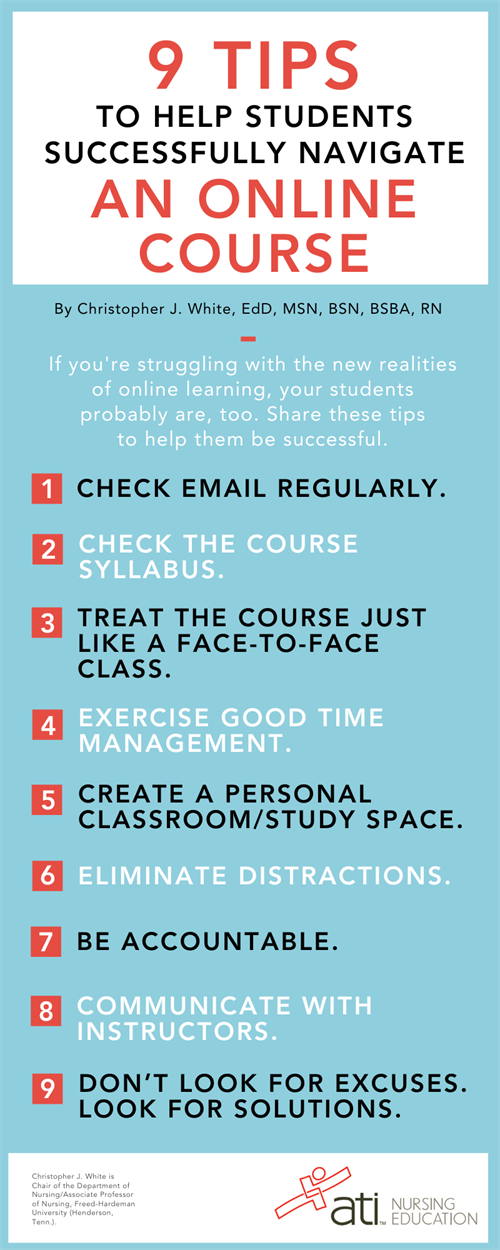9 TIPS TO HELP STUDENTS SUCCESSFULLY NAVIGATE AN ONLINE COURSE
Mar 16, 2020, 12:29 PM
<4-min. read> If you're a nurse educator who is struggling with the new realities of online learning, your students probably are, too. Share these tips to help them be successful in gaining the most from their courses.
By Christopher J. White, EdD, MSN, BSN, BSBA, RN, Chair, Department of Nursing/Associate Professor of Nursing, Freed-Hardeman University (Henderson, Tenn.)
 Due to unforeseen circumstances, you and your students have likely been put into a position in which you will need to participate in online courses to complete the semester. While some of your students may have had online courses before, some have not. It is important to help your students recognize that the online-course delivery model is going to require more active participation on their part.
Due to unforeseen circumstances, you and your students have likely been put into a position in which you will need to participate in online courses to complete the semester. While some of your students may have had online courses before, some have not. It is important to help your students recognize that the online-course delivery model is going to require more active participation on their part.Specifically, while they have sat in traditional face-to-face classes and tried to learn passively, online courses will require them to be more active in the learning process. They will have to read more, write more, listen more, and be more conscious of deadlines. The silver lining to this situation? It may provide them with an opportunity to improve their learning strategies, which can translate into improved performance in their traditional courses, as well, in the future.
You and your students can successfully navigate an online course. Everyone will have to be actively involved in the process to do so.
Here are some tips (and a downloadable infographic, at right) you can share with your students to help them:
1. CHECK EMAIL REGULARLY.
Email is a quick means of communication between you and your students. Remind them to use it to check for changes in syllabi, assignment due dates, course delivery, etc.2. CHECK THE COURSE SYLLABUS.
With the transition to an online delivery model, you will undoubtedly make some modifications to assignment submission, due dates, etc. You also may change your expectations of class “attendance” and absence. Review those sections with your students so they understand your expectations.3. TREAT THE COURSE THE SAME WAY THEY WOULD IF IT WAS FACE-TO-FACE.
While there will be differences, remind your students that they should treat the online delivery of your course the same way they would in a face-to-face situation. In other words: They should be present for the class at the regularly scheduled time, pay attention, submit assignments on time, be focused during that class period, etc. However, they will need to be more active in online learning – not just passively listening to try and learn.4. EXERCISE GOOD TIME MANAGEMENT.
The traditional schedule had students in class at a specified period. They should use that same period now to complete their online course. Again, remind them to review the syllabus and check their email to see whether you have made (or make) any changes to this schedule. Suggest that they try to maintain a routine schedule the same way they did while on campus.5. CREATE A CLASSROOM/STUDY SPACE.
Students should immerse themselves in a “classroom” environment in their homes that is free of distractions. Ensure they have good internet access and any other resources necessary during their scheduled class time.6. ELIMINATE DISTRACTIONS.
 The numerous distractions of a home environment can pull students away from their focus on the virtual classroom. Advise students to let their family know when they have “class/study” times and ask not to be disturbed during those periods. Other tips? Block social media/Netflix/TV or other entertaining technology during “class/study” time. (Apps are available to help students “block” social media, if necessary.)
The numerous distractions of a home environment can pull students away from their focus on the virtual classroom. Advise students to let their family know when they have “class/study” times and ask not to be disturbed during those periods. Other tips? Block social media/Netflix/TV or other entertaining technology during “class/study” time. (Apps are available to help students “block” social media, if necessary.)7. HOLD THEMSELVES ACCOUNTABLE.
Students must plan their days/weeks to ensure they are completing assigned work. Suggest they perform a daily/weekly review to ensure they are staying on track. If they discover they are giving in to distraction, advise them to find somewhere else to conduct their “class/study” time that will be less distracting, whether it's another part of their home or a secluded outdoor setting, such as a park where they can conduct social distancing. While the transition to the online format was not of their choosing, their performance in the course is a result of their choices. Let them know they have the ability to make wise ones.8. COMMUNICATE WITH THE FACULTY MEMBER.
It is important that students communicate with you to understand any new expectations you have. Suggest that they seek clarification from you anytime they are uncertain, and let them know they aren't alone. You, too, are having to significantly adjust to the online delivery model. Remind them you can all learn from each other. But to do so, everyone must communicate.9. DON’T LOOK FOR EXCUSES. LOOK FOR SOLUTIONS.
Neither you nor your students expected to suddenly switch to online courses. Circumstances dictated this necessary step to help ensure the safety and well-being of the everyone. Gently remind students not to use this unexpected change as an excuse for poor engagement and poor performance. The outcome they achieve will be directly related to the effort they put it into it.It’s a different format, but it's not impossible if they choose to commit themselves to actively engaging and staying on the path to success.
